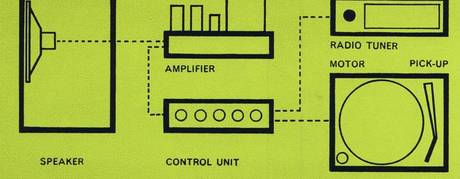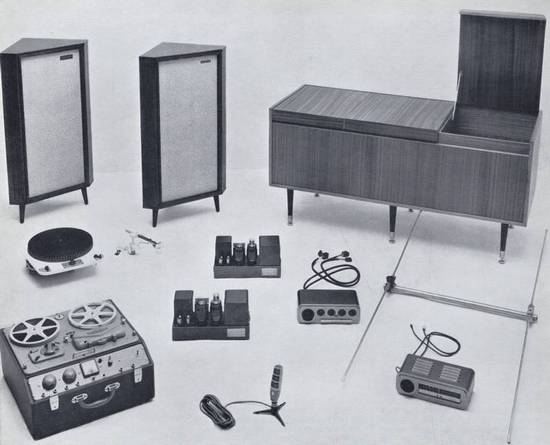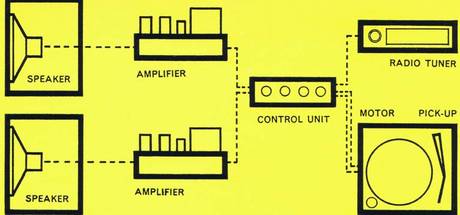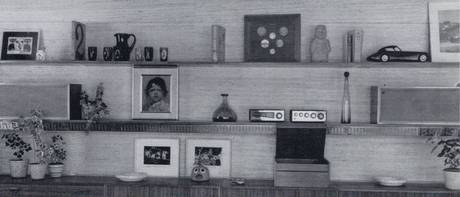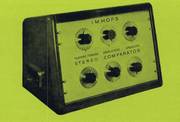Einblick in den Imhofs Hifi Katalog von 1962
Es ist etwas Besonderes, einen so gut erhaltenen Hifi-Katalog aus dem England von 1962 zu bekommen. Wir haben die Seiten so geschickt wie möglich aufgeteilt, sonst würde eine einzelne Seite zu lang werden. Blättern Sie oben in der weißen Leiste von Seite zu Seite.
1962 war der Begriff und die Bedeutung von "Hifidelity" noch lange nicht der großen Masse bekannt.
Wie in dem (den) Braun Hifi Stereo Brevier(en) ab Jahresende 1962 wurde auch in England dem potentiellen Kunden das ganze Drumherum um Stereo und Hifi nochmal ausführlich erklärt. Zugegebener Maßen ist das hier kein Vergleich mit den edlen 1963er Braun Publikationen, die wir bei uns inzwischen alle vorliegen haben.
-
what exactly is high fidelity?
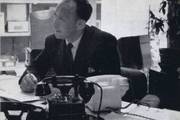
- Sydney Curtis, Retail Director with us for over fifteen years and has a tremendous fund of knowledge concerning hi-fi, radio and television. The glass walls of his office are indicative of the way in which he maintains personal contact with our customers. His door is always open if you want a word with him.
High fidelity is the striving towards the ideal in sound reproduction, the ideal of exactly reproducing the original sound. The aim of those who build and design hi-fi equipment is to create for you the sound of a whole orchestra precisely as if it were actually playing in your own home. With each year that passes, improvement in components and techniques make reproduction that much more faithful to the original, that much nearer perfection. If you remember the wind-up gramophone, you have only to listen to a modern hi-fi system to learn what "high fidelity" means.
To achieve such faithful reproduction, the components used must have a very wide frequency range, extending from 30 up to at least 20,000 cycles. Only then will you be able to distinguish the characteristics of individual instruments, the harmonics and overtones that give each its specific character. Such wide ranges bring their own problems of distortion which can only be overcome by better quality components.
Distortion is a problem with increasing volume, too, and a hi-fi system must aim at reproducing the effect of the full volume of an orchestral crescendo without distortion, an aim impossible to achieve with, for instance, a small radio set.
As the world's leading hi-fi specialists Imhofs can help you take the maximum advantage of these scientific developments.
what is stereo ?
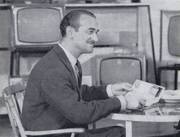
- A. M. Lester, Manager in the years he has been with the company, his signature and his voice have become familiar to customers the world over. His war-time experiences in charge of a radar unit combined with a love of music make a fine foundation for his knowledge of hi-fi. Bliss for him would be to spend his days taking colour photographs of Venice, his evenings listening to Bach or Big Bill Broonzy.
Stereophonic reproduction is a method of giving even greater realism to recordings of larger musical works by playing two separate recordings simultaneously through two loudspeakers. The two recordings are, of course, made simultaneously but with separate microphones, one on either side of the orchestra. Tape or disc records may be used, dual tracks on the record carrying the two recordings. A dual tape head or pick-up head is, of course, necessary to handle the two tracks.
The results obtained by this method give a fuller orchestral sound which is quite remarkable. Incidentally, the listener can also place the instruments within the orchestra and there are special records, such as one of a passing train, to emphasise this effect. Stereo equipment has developed considerably in the past year and some very good models are now available at reasonable prices. Even so, it is as well to emphasise that a hi-fi system is as good as its weakest component and that a lower quality stereo system cannot be as satisfying as a good single-channel system. Not all stereo instruments are hi-fi although they may be advertised as such. Imhofs will advise you which is best for your purpose for the price you can afford.
a mono hi-fi system
This diagram shows the basic components of a mono hi-fi system. On the right are the radio tuner and the turntable and pick-up for playing records. These are connected to the pre-amplifier (also known as the control unit) which enables you to switch from radio to records, to control the volume, and to adjust the quality. Next comes the main amplifier, to boost the signal from the tuner or pick-up to provide sufficient power to operate the loudspeaker. The control unit and main amplifier may be combined (and referred to simply as 'the amplifier') or they may be separate. Finally, there is the loudspeaker. The whole system is basically similar to a radiogram but here the individual items are all of high quality and you choose each item to suit your own requirements.
In England hieß es "budget-plan", in USA hieß es "value"
und das war dann das Billigste vom Billigen, daß noch irgendwie mit dem ursprünglichen Thema zusammen hing. In den USA war eine "Value Hifi Anlage" ein Gerät mit AM/FM Receiver mit 2 x 4 Watt Verstärker, 10fach Plattenspieler und Magnetbandgerät, sowie zwei (Hifi ????) Lautsprechern für ganze 99.- Dollar.
-
budget-plan hi-fi
Here is a (mono) hi-fi system in its simplest acceptable form. The two largest units are housed in matching cabinets finished in sapele mahogany, the two smaller in matt black covers with polished copper control panels. The record player incorporates a Garrard turntable and pick-up, the amplifier is the Pye Mozart amplifier, matched by the Pye FM radio tuner, and the speaker is the specially designed Imhof bookcase loudspeaker. It is a sign of the great strides which have been made in hi-fi that a system giving such remarkable fidelity of reproduction can be bought at such a reasonable price.
the connoisseur's hi-fi system
In the piture we have illustrated a stereophonic system which will give excellent results in most living-rooms. This is an individual's choice and broadly comparable results would be obtained if any components were exchanged for alternatives in the same class.
The turntable is the Garrard 301S transcription motor. Alternatively, a Connoisseur Model B might be used. The pick-up is the Garrard TPA.12, fitted with a Tannoy Vari-Twin stereo cartridge. Possible alternatives are the Decca ffss, the SME with Shure cartridge, or the Pickering 198. The tape machine is the Ferrograph 422U, a semi-professional machine which is supplied complete with carrying case but which could be housed in a cabinet if preferred.
Alternatives are the stereo Sony, or the Tandberg Model 6. With these machines, recordings can be made from records or radio and, with the addition of a microphone, from live speech or music. Illustrated here is the Simon Cadenza microphone. Others of similar quality are the Film Industries ribbon microphones.
The control unit here is the Acoustical Quad QC.22. Other fine stereo units include the Leak Varislope and the Rogers Master Control. The main amplifiers are a pair of Quad II amplifiers; alternatively, one might use a single Leak 'Stereo 20' power amplfier or a Rogers Junior.
The tuner illustrated is the Quad FM. Other high-grade FM tuners are the Leak Troughline II, the Pye AM/FM or Armstrong ST.3 may be used if reception of oversea broadcasts is required.
A good aerial (Anmerkung: Antenne) is essential for interference-free reception. The model shown here is the Antiference 220 dipole with reflector. The ultimate choice must depend on many factors and it is always worthwhile to draw on the experience of Imhofs service and installation department.
The loudspeakers are the most critical item in the chain of reproduction and must be chosen with special care. The pair shown are Tannoy Chatsworth enclosures fitted with Tannoy 12" Dual Concentric speakers. Other suitable speakers are the Acoustical Quad Electrostatic, the Wharfedale W3 or the Leak Sandwich and the Mordaunt Arundel, or you might choose to have your speakers built into the room.
Finally, the cabinet: the choice is governed by the equipment to be accommodated and the individual choice of style to blend with existing furniture. The Imhof HFU/10 cabinet shown here is designed to house all the equipment illustrated in three separate compartments, with access from the top.
In this way, when the equipment is not in use, it is completely concealed in a distinguished piece of furniture. This model is finished in light sapele mahogany, with black legs. Alternatively, your equipment could be housed in a period cabinet or in existing fitments, such as library shelves.
Installations such as these are a speciality of Imhofs craftsmen.
a stereophonic sound reproduction system
You can see from this diagram that a stereophonic sound reproduction system is a simple development of the single-channel system on page 7. The pick-up is a special one, capable of collecting signals from the two channels in the stereo record. The radio tuner is unchanged, although if stereo broadcasting ever becomes general you would add another. Then comes the stereo control unit (you could use two single-channel units but this is complicated), connected to two main amplifiers. Each of these is then connected to a loudspeaker. These are placed about six to eight feet apart, as a rule, and facing the listener.
stereo for the smaller home
A stereophonic system need not crowd the furniture out of the room nor the cigarettes out of the budget. This space-saving arrangement consists of a Garrard 4HF player with stereo pick-up in an Imhof cabinet NIB, a Pye HFS.20 M stereo amplifier, a Pye HFT.109 M tuner in a metal case and two Imhof book-case loudspeakers. This system gives reproduction of a quality similar to that of our single-channel budget-plan hi-fi on page 7, but with the additional fullness of sound that makes stereophonic reproduction so astonishingly authentic.
how to choose hi-fi equipment
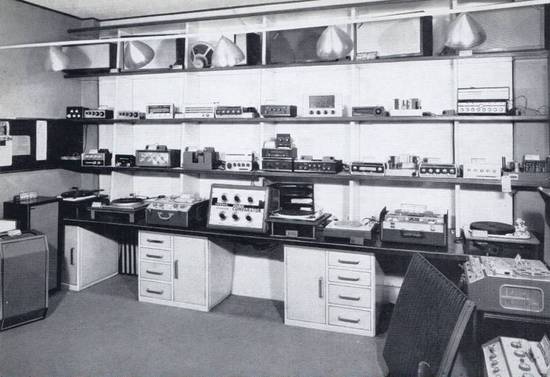
- One of Imhofs hi-fi demonstration rooms - Acoustically treated and sound-proofed to enable you to select equipment under the best possible conditions. Here is housed one of Imhofs comparators - in a room of a similar size to an average living room - and you may sit, in air-conditioned comfort, to choose the hi-fi system to suit your requirements.
Whether you are interested mainly in listening to music or in playing with recalcitrant electrons, you will take a lot of care in choosing hi-fi equipment. It will simplify matters if you study the literature first and in this catalogue you will find technical details of all the best equipment in the various price ranges.
The question of price is important and you will, of course, want the best performance you can afford (many of us hanker for a Continental Bentley but settle, happily, for a Mini-Cooper); you can choose equipment from these pages with complete confidence. A technical description is given of each component and at the head of each section are notes for those who would like a little guidance in making their selection.
Other points to consider are the type of music you want to listen to and whether you are primarily interested in records or in radio. The size of your room is important too. Then it is also useful if you decide whether you will want to add to your system later and whether you want to listen to stereo, perhaps at a later date. If you would like advice on equipment to suit your special requirements, we should be happy to give it.
Having made your preliminary choice we should like you to come and hear it in our showrooms. Using the new Imhofs Stereo Comparator, you can compare alternative choices at the click of a dial (many thousands of different arrangements are possible with this unique instrument).
Then there are new stereo listening rooms, adapted to create conditions as near those in your home as possible, in which you can judge stereo for yourself.
If you cannot call in but would like a second opinion on possible systems to fit your home, your tastes and your pocket, do not hesitate to write giving the details. Mr. Curtis, Mr. Lester and their staff are always delighted to help.
Imhofs Stereo Comparator (Anmerkung : 1962)
The Stereo Comparator is an instrument devised and made by us to enable customers to hear in our demonstration rooms as wide a range of hi-fi systems as possible without loss of time.
There are three pairs of control switches, one for players and tuners, one for amplifiers and one for speakers. Each switch can control twenty-five components so that one could link 150 different hi-fi components in thousands of different combinations.
This means that you can walk into one of Imhofs demonstration rooms, specify the equipment which interests you (with perhaps every item manufactured by a different company) and sit down at once to listen to it. Each component wired to the Stereo Comparator has a pilot light attached to its label so that you can see which are operating at a given moment.
-


